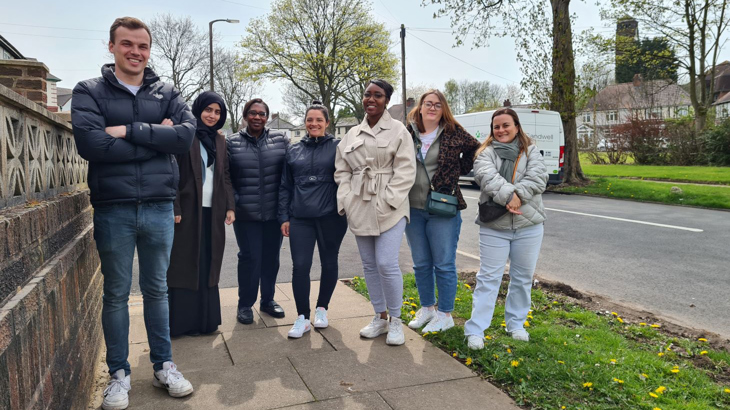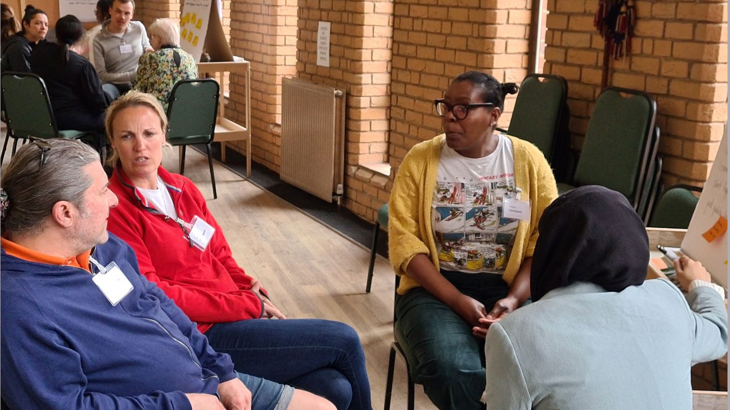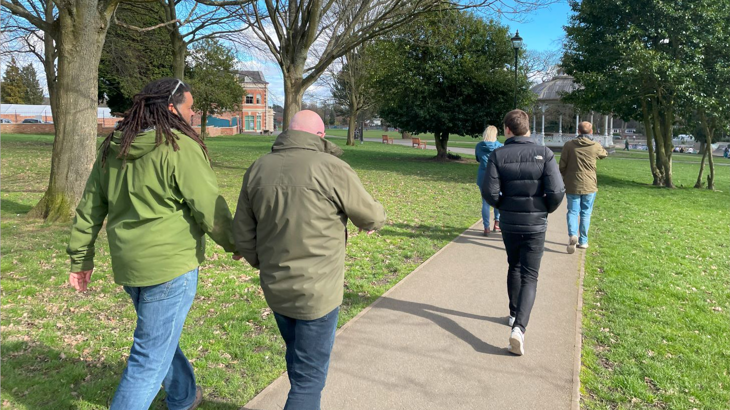Residents in the West Midlands and the South of England came together to explore what helps and hinders walking, cycling and wheeling in their local area. In this blog, Jamie Hearing, a researcher at Hopkins Van Mil who worked on the project, reflects on the process of bringing people together for these conversations.

Participants in the Dialogue Report, a project that aims to understand the barriers and enablers of active travel by listening to a variety of lived experiences. Credit: Hopkins Van Mil
Earlier this year, the team at Hopkins Van Mil worked with Sustrans to run a series of workshops exploring people’s views on everyday walking, cycling and wheeling in the areas they live in.
Sustrans commissioned the work to understand, in more depth, the aspects of people’s lives and neighbourhoods that promote different kinds of active travel, and those which get in the way.
Engaging in mini dialogues
To do this we carried out a ‘mini dialogue’, adopting a form of deliberative research which allows people to connect with and explore an issue over time in conversation with other participants and stakeholders.
By providing time and space, different views can emerge and develop during the process.
Choosing diverse neighbourhoods
We chose to run the workshops in two neighbourhoods of a similar size but with differences in the infrastructure and opportunities available for walking, cycling and wheeling.
This led us to St Denys, in Southampton, for one set of workshops, where traffic filters, continuous pavements and cycle lanes have been installed since it became the city’s first Active Travel Zone.
It also has Route 23 of the National Cycle Network running through it.
For the other set of workshops we went to Bearwood, a neighbourhood in Sandwell near Birmingham, which has highly cherished green spaces but less evidence of walking and cycling infrastructure on its streets and is a mile or more from a National Cycle Network route.
Diverse participants, varied perspectives
In both Bearwood and St Denys, the workshops were attended by a small but diverse group of local residents who had been recruited via community outreach.
In total, 32 people took part, 18 in Bearwood and 14 in St Denys, ranging in age from those in their early 20s to those in their 70s.
They brought with them a range of experiences, habits and attitudes relating to travel.

Participants in the workshop discussed their views on walking, cycling, and wheeling. Credit: Hopkins Van Mil
In-depth workshops and insights
The majority of participants were car owners, with half making most of their journeys by vehicle or via public transport.
This was crucial for Sustrans to hear the perspectives of people who don’t walk or cycle much already.
All the participants attended two full-day workshops held one month apart in local community venues.
There were discussions in pairs and small groups, walk and talk activities to observe local infrastructure, and presentations with Q&As sessions by Sustrans staff and local active travel officers.
We also created an online space where participants kept travel diaries and recorded interviews with family and friends during the project, as well as annotated maps of their local area.
Insights from the community
As facilitators at the workshops, we experienced first-hand the depth of the insight people can contribute to this topic, from the ways in which local journeys can change once you have dependents, such as young children, to the long list of factors that make an environment hostile for walking or wheeling.
Participants not only brought their own experiences to the discussions, but also their own form of expertise accrued from living and moving around their neighbourhoods every day.
We recorded and transcribed our discussions and analysed these alongside the responses shared in the online space to ensure our report was rooted in what people told us.

Participants in the Dialogue Report workshop walking and talking in the neighbourhood. Credit: Hopkins Van Mil
Understanding barriers and enablers
Our discussions and subsequent analysis were framed in terms of what helps and what hinders walking, cycling and wheeling.
In contrast to walking, where benefits such as time to oneself, socialising or connecting with nature were often mentioned, views expressed about cycling focussed more on the presence or absence of wider factors such as infrastructure, training and equipment.
Cycling was often associated with a strong sense of danger or risk in a way which walking or other modes of travel were not.
The extent of this hurdle varied between participants.
However, we heard consistently that the greatest enabler of cycling is dedicated, safe space.
Celebrating community voices
We are extremely grateful to all the people who contributed to this process.
This includes the workshop speakers, who helped to inform discussions in thought-provoking style, venue hosts and the project team at Sustrans.
Particular thanks go to the participants in St Denys and Bearwood.
They gave us two of their Saturdays and considerable time spent on the online space sharing their stories and those of their friends and families.
Everybody who took part had a different story to tell, whether they had lived in the area for six months or sixty years.
They listened to each other and questioned each other and our speakers with respect and good humour.
They showed us around their neighbourhoods even when the weather was what you would expect for a day early spring.
Their pride in where they live is strongly felt and palpable.
It was an honour for us as researchers to spend time with them.
To find out more about the use of dialogue in research visit hopkinsvanmil.co.uk or get in touch with the team at info@hopkinsvanmil.co.uk.

About the author
Jamie Hearing is a social researcher based at Hopkins Van Mil.
They create safe, impartial and productive spaces in which to explore and gain an understanding of people’s views on the issues which matters to them, to stakeholders, and to society.





